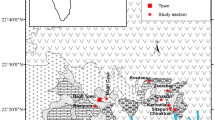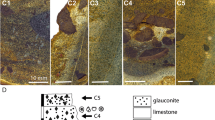Abstract
The Late Cretaceous (Cenomanian to Coniacian) marine sediments of central India prevalently known as ‘Bagh Beds,’ have been deposited in the E-W extending Narmada Basin. The stratigraphy of these Cenomanian — Coniacian sediments has been reviewed and summarized. The Bagh Beds have been found to consist of three formations: Nimar Sandstone, Nodular Limestone and Corallian Limestone in ascending order. Main emphasis has been given to Nodular Limestone Formation (Turonian), which is the most fossiliferous horizon of the Bagh Beds. Nodular Limestone Formation has more or less alternating bands of varying thickness of nodular limestone and marl. It yielded numerous ammonoid specimens, which have been found to belong to a morphologically highly variable ammoniod taxon Placenticeras mintoi Vredenburg.
Similar content being viewed by others
References
Acharya, S.K. and Lahiri, T.C. (1991) Cretaceous palaeogeography of Indian subcontinent: a review. Cretaceous Res., v.12, pp.3–26.
Akhtar, K. and Khan, D.A. (1997) A tidal island model for carbonate sedimentation: Karondia Limestone of Cretaceous Narmada basin. Jour. Geol. Soc. India, v.50, pp.481–90.
Badve, R.M. and Nayak, K.K. (1984) Occurrence and significance of the algae genus Hallmeda from Nimar sandstone, Bagh beds, Jhabua, M.P. Biovigyanam, v.9, pp.137–148.
Bardhan, S., Gangopadhyay, T.K. and Mandal, U. (2002) How far did India drift during the Late Cretaceous?-Placenticeras kaffrarium Etheridge,1904 (Ammonoidea) used as a measuring tape. Sed. Geol., v.147, pp.193–217.
Biswas, S.K. (1987) Regional tectonic framework structure and evolution of western marginal basins of India. Tectonophysics, v.135, pp.307–327.
Blanford, W.T. (1869) On the geology of Tapti and lower Narbada Valley and some adjoining districts. Mem. Geol. Surv. India, v.6(3), pp.163–384.
Bose, P.N. (1884) Geology of Lower Narbada Valley between Nimavar and Kawant. Mem. Geol. Surv. India, v.21, pp. 1–72.
Bose, P.K. and Das, N.G. (1986) A transgressive storm-and fairweather wave dominated shelf sequence: Cretaceous Nimar Formation, Chakrud, Madhya Pradesh, India. Sed. Geol., v.46(1–2), pp.147–167.
Chiplonkar, G.W. (1941) Ammonites from Bagh Beds. Proc. Indian Natln. Acad. Sci., v. B14, pp.271–276.
Chiplonkar, G.W. and Badve, R.M. (1973) Age and affinities of the Bagh fauna-a re-assessment. Proc. Indian Natl. Acad. Sci., v.45, pp.19–29.
Chiplonkar, G.W. and Ghare, M.A. (1976) Palaeontology of Bagh Beds-Part VII: Ammonoidea. Bull. Earth Sci., v. 4&5, pp.1–10.
Chiplonkar, G.W. and Ghare, M.A. (1977a) Palaeontology of Bagh Beds. Pt. X. Scaphitiae. Proc. Indian Natnl. Acad. Sci., v.85B (2), pp.67–76.
Chiplonkar, G.W. and Ghare, M.A. (1977b) Comments on Proplacenticeras stantoni (Hyatt) and its variety bolli (Hyatt). Jour. Univ. Poona, Sci. Tech., v.50, pp.221–226.
Chiplonkar, G.W. and Ghare, M.A. (1977c) Ammonoidea from the Bagh Beds of Narmada valley. Indian Jour. Earth Sci., v.4(2), pp.109–116.
Chiplonkar, G.W., Ghare, M.A. and Badve, R.M. (1977) Bagh Beds -their fauna, age and affinities: a retrospect and prospect. Biovigyanam, v.3, pp.33–66.
Dassarma, D.C. and Sinha, N.K. (1975) Marine Cretaceous Formation of Narmada valley, BaghBeds, Madhya Pradesh and Gujarat. Pal. Indica (N.S.), v.42, 10p.
Gangopadhyay, T.K. and Bardhan, S. (1998) Apertural modifications and jaw structures of placenticeratid ammonites from the Upper Cretaceous Bagh Group, central India. Neues Jahr. Geol. Pal.-Monatshefte, v.4, pp.193–202.
Gangopadhyay, T.K. and Bardhan, S. (2007) Ornamental polymorphism in Placenticeras kaffrarium (Ammonoidea; Upper Cretaceous of India): Evolutionary implications. In: N.H. Landman, R.A. Davis and R.H. Maps (Eds.), Cephalopods: Present and Past. New Insights & fresh perspectives. Springer, pp.97–120.
Ganguly, T. and Bardhan, S. (1993) Dimorphism in Placenticeras mintoi from the Upper cretaceous Bagh Beds, central India. Cretaceous Res., v.14, pp.757–756.
Guha, A.K. (1976) Lithostratigraphic classification of Bagh Group(Beds), Madhya Pradesh. Proc. IV Colloq. Micropal. Strat., Dehra Dun, pp.209–216.
Jafar, S.A. (1982) Nanoplankton evidence of Turonian transgression along Narmada Valley, India and Turonian-Coniacian boundary problem. Jour. Pal. Soc. India, v.27, pp.17–30.
Jain, S.P. (1969) Taxonomic comments on ammonites from Bagh Beds, M.P. with remarks on the age of the beds. Bull. Indian Geol. Assoc., v.2, pp.45–48.
Kennedy, W. J., Phansalkar, V.G. and Walaszczyk, I. (2003) Prionocyclus germari (Reuss, 1845), a Late Turonian marker fossil from the Bagh Beds of central India. Cretaceous Res., v.24(4), pp.433–438.
Kennedy, W.J. and Wright, C.W. (1983) Ammonites polyopsis Dujardin, 1837 and the Cretaceous ammonite family Placenticeratidae Hyatt, 1900. Palaeontology, v.26, pp.855–873.
Klinger, H.C. and Kennedy, W.J. (1989) Cretaceous faunas from Zululand and Natal, South Africa. The ammonite subfamily Placenticeratidae Hyatt, 1900; with the comments on the systematic position of the genus Hypengonoceras Spath, 1924. Annal. South African Mus., v.98(9), pp.241–408.
Kumar, S., Singh, M.P. and Mohabey, D.M. (1999) Lameta and Bagh Beds, Central India, Field Guide. Jour. Pal. Soc. India, 48p.
Kundal, P. and Sanganwar, B.N. (1998) Stratigraphical, palaeogeographical and palaeoenvironmental significance of fossil calcareous algae from Nimar Sandstone Formation, Bagh Group (Cenomanian-Turonian) of Pipaldehla, Jhabua Dt, MP. Curr. Sci., v.75(7), pp.702–703.
Lees, J.A. (2008) The calcareous nanofossil across the Late Cretaceous Turonia/Coniacian boundary, including new data from Germany, Poland, Czech Republic and England. Cretaceous Res., v.29(1), pp.40–64.
Nayak, K.K. and Badve, R.M. (1985) Bivalvia from Nimar Sandstone, Bagh Beds, Jhabua District, Madhya Pradesh. Biovigyanam, v.11, pp.77–86.
Pal, A.K. (1971) A note on the biozonation of the Bagh Group of Madhya Pradesh. Indian Sci. Cong. Assoc. Proc. Fifty-Eight session, Bangalore, Pt. III, p.332.
Raiverman, V. (1975) Facies transition along Nimar, Bagh and Lameta Beds. Rec. Res. Geol., v.2, pp.123–139.
Ramasamy, S. and Madhavaraju, J. (1993) Petrographic studies of the Bagh Beds along the Narmada Valley in Madhya Pradesh, India. Gondwana Geol. Mag., v.4/5, pp.65–79.
Reinhardt, E.G., Cavazza, W., Patterson, R.T. and Blenkinsop, J. (2000) Differential diagenesis of sedimentary components and the implication for strontium isotope analysis of carbonate rocks. Chem. Geol., v.164, pp.331–343.
Rode, K.P. and Chiplonkar, G.W. (1935) A contribution to the stratigraphy of Bagh Beds. Curr. Sci., v.2, pp.322–323.
Roy Chowdhary, M.K. and Sastri, V.V. (1962) On the revised classification of the Cretaceous and associated rocks of the Man River section of lower Narbada Valley. Rec. Geol. Surv. India, v.91(2), pp.283–301.
Sahni, M.R. and Jain, S.P. (1966) Note on a revised classification of the Bagh Beds, Madhya Pradesh. Jour. Pal. Soc. India, v.11, pp.24–25.
Sarkar, S.S. (1966) On Placenticeras mintoi VREDENBURG 1908, from the Bagh Beds (Cretaceous) of India. Pal. Z., v.40(1/2), pp.144–146, 11 pl.
Sastri, V.V., Raju, A.T.R., Shukla, S.N. and Venkatachala, B.S. (1982) Narmada basin. ESCAP atlas of stratigraphy III, stratigraphic correlation between sedimentary basins of the ESCAP region. Mineral Resources, Development Series, v.48, pp.36–49.
Schurrenberger, D., Russell, J. and Kerry, K. (2003) Classification of lacustrine sediments based on sedimentary components. Jour. Paleolim., v.29, pp.141–154.
Singh, I.B. (1981) Palaeoenvironment and palaeogeography of Lameta Group sediments (Late Cretaceous) in Jabalpur area, India. Jour. Pal. Soc. India, v.26, pp.38–53.
Singh, S.K. and Srivastava, H.K. (1981) Lthostratigraphy of the Bagh Beds and its correlation with Lameta Beds. Jour. Pal. Soc. India, v.26, pp.77–85.
Tandon, S.K. (2000) Spatio-temporal patterns of environmental changes in the Late Cretaceous sequences of Central India. Dev. Pal. Stratigr., v.17, pp.225–241.
Taylor, P. and Badve, R.M. (1995) A new cheilostome bryzoan from the Cretaceous of India and Europe: A cyclostome homeomorph. Palaeontology, v.38(3), pp.627–657.
Tripathi, S.C. (1995) Palaeontological and palaeoenvironmental studies of Bagh Group, M.P. Rec. Geol. Surv. India, v.128(6), pp.104–105.
Tripathi, S.C. (2006) Geology and evolution of the Cretaceous Infratrappean Basins of Lower Narmada Valley, western India. Jour. Geol. Soc. India, v.67, pp.459–468.
Vredenburg, H.W. (1907) The Ammonites of the Bagh Beds. Rec. Geol.Surv. India, v.36(2), pp.109–25.
Vredenburg, H.W. (1908) Additional note concerning a previous notice on “The Ammonites of the Bagh Beds”. Rec. Geol. Surv. India, v.36(3), pp.239–240.
Westerman, G.E.G. (1990) New developments in the ecology of Jurassic-Cretaceous ammonoids. In: G. Pallini, F. Cecca, S. Cresta and M. Santontonio (Eds.), Atti del Secondo Convegno Internazoinale Fossilli, Evolutione, Ambiente, Pergola, 1987, pp.459–478.
Westphal, H., Head, M.J. and Munnecke, A. (2000) Differential diagenesis of rhythmic limestone alternations supported by palynological evidence. Jour. Sed. Res., v.70, pp.715–725.
Westphal, H. and Munnecke, A. (2003) Limestone-marl alternations: A warm-water phenomenon? Geology, v.31(3), pp.263–266.
Wheeley, J.R., Cherns, L. and Wright, V.P. (2008) Provenance of microcrystalline carbonate cement in limestone-marl alternations (LMA): aragonite mud or molluscs? Jour. Geol. Soc. London, v.165(1), pp.395–403.
Author information
Authors and Affiliations
Corresponding author
Rights and permissions
About this article
Cite this article
Jaitly, A.K., Ajane, R. Comments on Placenticeras mintoi (Vredenburg, 1906) from the Bagh Beds (Late Cretaceous), central India with special reference to Turonian Nodular Limestone Horizon. J Geol Soc India 81, 565–574 (2013). https://doi.org/10.1007/s12594-013-0072-0
Received:
Revised:
Published:
Issue Date:
DOI: https://doi.org/10.1007/s12594-013-0072-0




